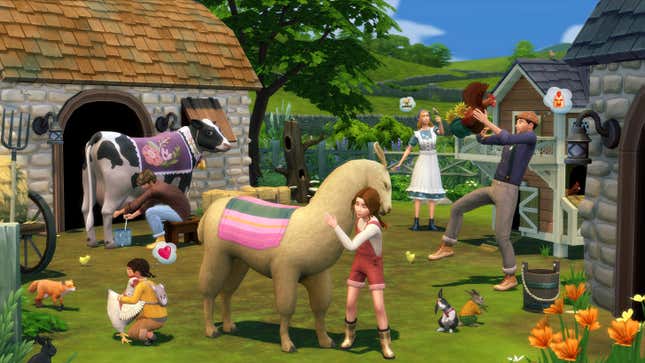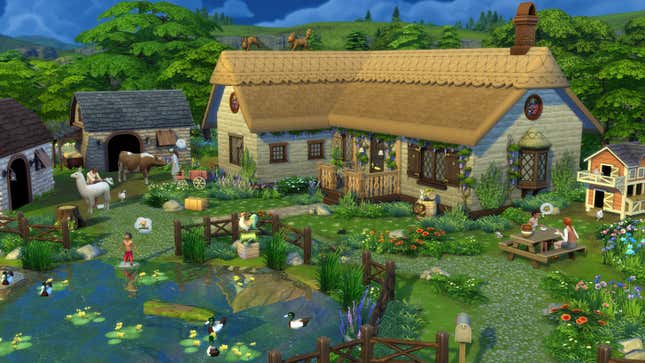
There are some “must-haves” for fans of The Sims. These are staples that are so ingrained in our IRL worlds or the franchise that a Sims game feels lacking without them: Attending university, having a pet, changing seasons, family gameplay, something magical or otherworldly, oh, and farming.
While the Maxis team behind The Sims 4 has delivered on most of these demands, Simmers continued clamoring for a farming expansion seven years after the entry’s release. With the Cottage Living expansion pack, the Sims team has finally made good on an unspoken promise.
Cottage Living is an expansion pack, the largest DLC type for the game, that brings the new world of Henford-on-Bagley, animal rearing, and farming. Henford-on-Bagley takes clear inspiration from “the rolling hills and rustic, quaint cottages of the English countryside,” as Antonio Romeo, the game’s lead producer, put it to Kotaku. Besides breaking up the routine of U.S.-centric worlds, The Sims 4 has a sizable fanbase in the U.K., along with a strong cohort of streamers from the area.
Players can also raise chickens, cows, and llamas. If you’re wondering why llamas would be included in a farming pack, llamas are the unofficial mascot of The Sims. The games have included numerous llama references since the first iteration, like university mascots, and jokes about feeding them. Also, llama farms are apparently a thing in the U.K.! So there!
And while growing plants, flowers, herbs, and the like have been in the base game and even added to in the Seasons expansion pack, Cottage Living obviously had to up the ante. The DLC adds not only new “normal” crops but also the ability to grow oversized crops that take up more space and take longer to grow. They can also be submitted to the Finchwick Fair, which takes place in Henford-on-Bagley. And, yes, eggplants are one of the oversized crops.
Cottage Living also excels in its widespread appeal by throwing in details for players that aren’t interested in packing up their virtual homes and settling into the country life. Arguably one of the most important reasons to purchase any of the DLC packs comes from the new items. Build/buy items, which are used when creating or changing a house or other buildings, are key details for any player. It’s especially crucial for builders, who are Simmers that are booting up the game largely for its architectural abilities.
There are also a fair amount of Create-a-Sims items, like hair, clothing, tattoos, or other “Sim” details. This might be the weakest element of Cottage Living, if only because of its strengths elsewhere.
As far as non-farming gameplay, Henford-on-Bagley is impressive. It’s one of the prettiest DLC worlds The Sims 4 has come out with in a while. That’s a testament to both the quality of Henford-on-Bagley and the underwhelming nature of some, though not all, of the more recent pack locations.

And there are a few activities that don’t involve farming, like cross-stitch and the ability to buy and use groceries in cooking, should making it yourself prove too onerous. (In the words of Barefoot Contessa Ina Garten, “Store bought is fine.”)
But other details, like cooking with children and lot challenges, were also added as base game updates.
Lot challenges, still, are a major gameplay upgrade. Rather than using a lot trait slot, which can add character to the world and story building, traits that add a level of difficulty can now be added as separate lot challenges. The base game only has the “off-the-grid” challenge, but Cottage Living adds the “simple living” and “wild foxes” challenges. There are plenty of other traits from other DLC packs that were turned into challenges, as well.
And diehard Sims fans will love that added lore. Without getting too in the weeds, The Sims 4 exists on a different timeline than the other Sims games. This means some classic NPCs have changed or disappeared entirely. Sims resident Agnes Crumplebottom makes her triumphant return in Cottage Living, which is a nice nod to longtime hardcore Simmers.
The Cottage Living formula has been a massive success for the EA and the franchise, which has been staring down a growing fandom revolt for more than a year. In fact, Cottage Living’s success only highlights the precarious situation between the franchise and its fervid fans. Players have grown increasingly impatient with unpopular DLC, the game’s slowness at addressing issues of diversity, and persistent bugs. But Cottage Living is a hell of a step in the right direction.
The response on social media has been overwhelmingly positive, with relatively minor details being nitpicked. Some took issue with the time between announcement and launch, which is typically very small, especially by industry standards. And, of course, horses. Anyone somewhat familiar with the Sims fanbase will likely be aware of the group’s massive desire for horses to be included in the game. Cottage Living does not include horses, much to the chagrin of some players.
“Making horses with the quality and depth of gameplay they deserve is a substantial undertaking,” Romeo told Kotaku via email. “We felt they were not core to the garden-to-table experience, so we focused on the animals that are in Cottage Living.”
Equine obsessions aside, Cottage Living is already poised to go down as one of the greatest Sims 4 expansions, a feat commendable for a seven-year-old game. But The Sims is not like most games.
So while the Maxis developers behind Cottage Living breathe in a sigh of relief, the questions already lingering—for them and for players—is, “What’s next?”